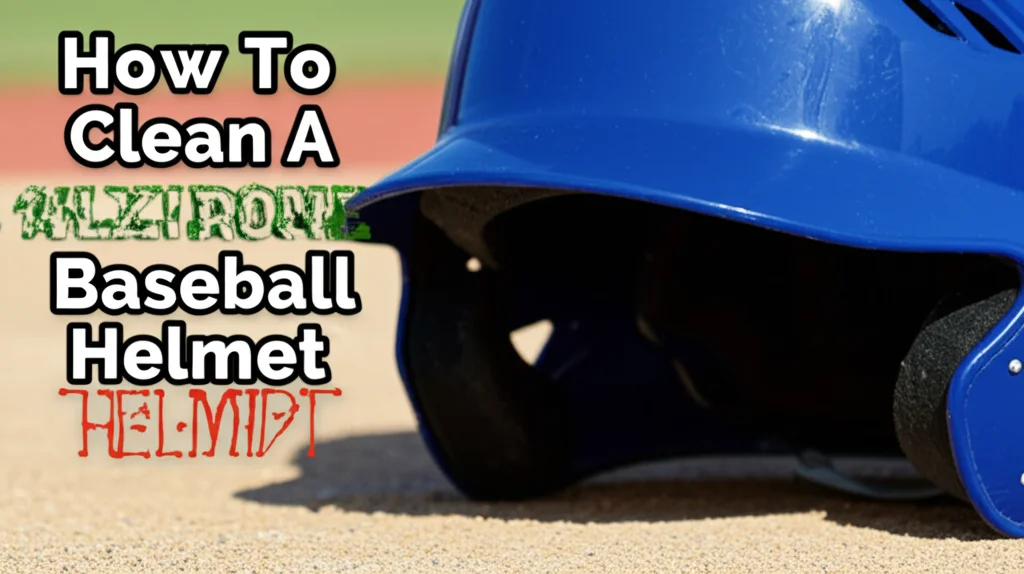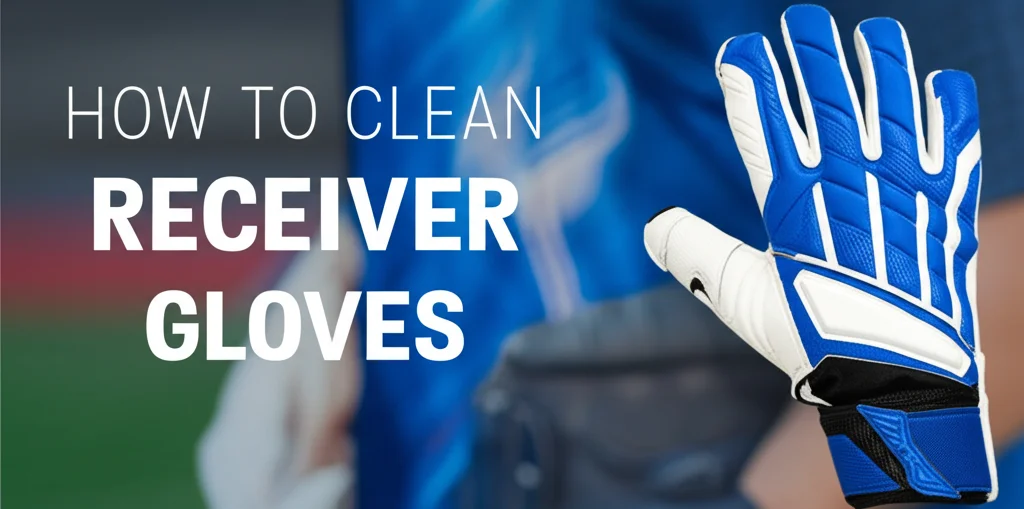· Sports Equipment · 18 min read
How To Clean A Baseball Helmet

How to Clean a Baseball Helmet: The Ultimate Guide
Key Takeaways
- Regular cleaning extends your baseball helmet’s lifespan and maintains safety
- Different cleaning approaches needed for helmet shells and interior padding
- Household products like mild soap and disinfectant spray work effectively
- Special techniques required for removing stubborn stains like pine tar
- Air-drying completely before use prevents mildew and odors
Quick Answer: To clean a baseball helmet, remove interior padding if possible, wash the shell with mild soap and warm water, disinfect and deodorize the padding with sports equipment spray, and air dry completely before reassembling and using.
Why Regular Baseball Helmet Cleaning Matters
Baseball helmets are essential protective gear that shield players from potentially serious head injuries during games and practice. However, with regular use, these helmets accumulate dirt, sweat, oils, and bacteria that can not only create unpleasant odors but also potentially compromise the helmet’s integrity and safety features over time.
Regular cleaning and maintenance of your baseball helmet serves multiple important purposes. First and foremost, it ensures proper hygiene, especially when helmets are shared among team members. A clean helmet prevents the spread of skin conditions, lice, and other communicable issues that can easily transfer from one player to another through shared equipment.
Beyond hygiene concerns, proper cleaning extends the lifespan of your helmet. Sweat contains salt and acids that can gradually break down helmet materials, particularly the interior padding that provides crucial shock absorption. Regular maintenance prevents premature deterioration of these safety components, ensuring your helmet continues to provide optimal protection.
Additionally, a well-maintained helmet simply performs better. Excessive dirt and grime buildup can affect the helmet’s fit, making it less comfortable and potentially less effective at protecting against impacts. For players who own personal helmets, keeping them clean also maintains their appearance, allowing team colors and logos to remain vibrant and professional-looking.
Whether you’re a player, coach, parent, or equipment manager, understanding how to properly clean a baseball helmet is an essential skill that contributes to player safety, equipment longevity, and team hygiene. In the following sections, we’ll break down exactly how to tackle different cleaning scenarios, from routine maintenance to dealing with stubborn issues like pine tar or persistent odors.
Essential Supplies for Cleaning Baseball Helmets
Before diving into the cleaning process, gathering the right supplies will make the task much more efficient and effective. Having everything ready prevents interruptions and ensures you’re using appropriate products that won’t damage your valuable equipment. Here’s what you’ll need:
Basic Cleaning Supplies:
- Mild dish soap or gentle shampoo
- Warm water
- Soft microfiber cloths or non-abrasive sponges
- Small bowl or bucket
- Clean spray bottle
- Old toothbrush or soft-bristled brush for detail cleaning
Disinfecting and Deodorizing:
- Sports equipment disinfectant spray (specifically formulated for sports gear)
- White vinegar (natural disinfectant alternative)
- Baking soda (for odor absorption)
- Isopropyl alcohol (70%) for sanitizing (use cautiously)
For Specialized Cleaning Challenges:
- Rubbing alcohol or specialized pine tar remover
- Hydrogen peroxide (for tough stains)
- Cotton balls or cotton swabs for targeted cleaning
- Magic erasers for scuff marks on matte surfaces
- Leather conditioner (if your helmet has leather components)
- Lice treatment kit (if dealing with lice infestation)
When selecting cleaning products, opt for mild, non-bleach formulations that won’t degrade plastic, foam, or fabric materials. Avoid harsh chemicals like ammonia, bleach, or abrasive cleaners that can damage the helmet’s protective shell or compromise the integrity of the interior padding.
For those concerned about using chemical cleaners, several effective natural alternatives exist. A solution of equal parts white vinegar and water serves as an excellent natural disinfectant, while baking soda works wonderfully for absorbing and neutralizing odors without harsh fragrances.
Having these supplies ready will prepare you for both routine maintenance cleaning and addressing specific issues like stubborn stains, unpleasant odors, or pest problems that occasionally affect baseball helmets.
Step-by-Step Guide to Basic Helmet Cleaning
Regular maintenance cleaning should be performed throughout the season to keep your baseball helmet in top condition. Here’s a comprehensive step-by-step process that works for most standard baseball helmets:
1. Disassemble the Helmet
- Remove any detachable components like ear flaps, chin straps, or face guards.
- If possible, separate the interior padding from the outer shell (check manufacturer’s guidelines as some helmets have fixed padding).
- Set aside any electronic components or specialized features that shouldn’t get wet.
2. Cleaning the Outer Shell
- Fill a small bucket or sink with warm (not hot) water.
- Add a small amount of mild dish soap or gentle shampoo to create a light soapy solution.
- Dip a soft microfiber cloth or non-abrasive sponge into the solution and wring out excess water.
- Gently wipe down the entire exterior surface of the helmet, paying special attention to vent holes and crevices where dirt accumulates.
- For stubborn dirt, use an old toothbrush dipped in the soapy solution to gently scrub affected areas.
- Rinse the shell thoroughly with clean water to remove all soap residue.
- Wipe down with a clean, dry cloth to remove excess moisture.
3. Cleaning the Interior Padding
For removable padding:
- Submerge in a bowl of warm soapy water and gently agitate to loosen dirt and oils.
- For heavily soiled padding, allow it to soak for 15-20 minutes.
- Gently squeeze (don’t wring) the padding to work the soap through the material.
- Rinse thoroughly with clean water until no soap bubbles remain.
For non-removable padding:
- Dampen a cloth with your soap solution and gently dab at the padding (avoid saturating).
- Use minimal water to prevent excessive moisture that can be difficult to dry.
- Follow up with a clean, damp cloth to remove soap residue.
4. Disinfect All Components
- Spray appropriate disinfectant on both the shell and padding components.
- Ensure you’re using a product safe for sports equipment that won’t damage the materials.
- Pay particular attention to areas that contact the skin directly.
- Allow the disinfectant to work according to product instructions (typically 5-10 minutes).
5. Thorough Drying Process
- Air-dry all components in a well-ventilated area away from direct sunlight.
- Never use heat sources like hair dryers, heaters, or place in a clothes dryer, as heat can warp the shell or damage padding.
- For faster drying, place absorbent paper towels inside the helmet to draw out moisture.
- Ensure the helmet is completely dry before reassembly – this typically takes 24 hours for thorough drying.
6. Reassemble the Helmet
- Once everything is fully dry, put all components back together.
- Check that padding is properly secured and positioned correctly.
- Ensure any mechanical parts like face guards or chin straps are properly attached and functioning.
Following this basic cleaning routine after games or practices—or at minimum, weekly during active seasons—will keep your baseball helmet hygienic, odor-free, and in excellent condition for optimal protection. For shared team equipment, consider implementing this cleaning protocol between different users to prevent the spread of skin conditions or other communicable issues.
How to Clean a White Baseball Helmet
White baseball helmets make a striking statement on the field, but they also show dirt, scuffs, and discoloration more readily than darker colors. Keeping a white helmet looking pristine requires special attention and sometimes different cleaning techniques than those used for colored helmets. Here’s how to maintain that bright, clean appearance:
Regular Maintenance for White Helmets
White helmets benefit from more frequent cleaning to prevent stains from setting in. Consider wiping down the exterior after each use with a damp microfiber cloth to remove surface dirt before it becomes embedded in the finish.
Deep Cleaning Process for White Helmets:
Pre-treat visible stains: Before general cleaning, address any noticeable marks:
- For grass stains: Create a paste of baking soda and water, apply to the stain, let sit for 15 minutes, then gently scrub with a soft toothbrush.
- For dirt scuffs: Magic erasers work wonders on white surfaces without damaging the helmet’s finish.
Gentle whitening solution: Mix a solution of:
- 1 tablespoon mild dish soap
- 1 tablespoon baking soda
- 1 cup warm water
Apply the solution with a soft cloth using circular motions across the entire surface. The baking soda acts as a gentle abrasive to lift stains while brightening the white finish.
Rinse thoroughly with clean water, ensuring no residue remains that could attract more dirt.
For persistent yellowing or discoloration:
- Create a paste using hydrogen peroxide and baking soda
- Apply to discolored areas and allow to sit for 30-45 minutes
- Gently scrub with a soft brush
- Rinse completely and dry
What to Avoid with White Helmets:
- Bleach: While tempting for white items, bleach can damage the helmet’s structural integrity and should never be used.
- Abrasive cleaners: These can create micro-scratches that actually trap dirt and make the helmet look duller over time.
- Extended sun exposure: While drying, keep white helmets out of direct sunlight, which can cause yellowing of the plastic over time.
Protective Measures:
After cleaning, consider applying a UV-protective spray designed for plastic sports equipment to prevent yellowing. Store white helmets in a helmet bag or covered container when not in use to prevent dust accumulation and environmental discoloration.
With consistent care using these specialized techniques, your white baseball helmet can maintain its bright, crisp appearance throughout multiple seasons, making you look professional and put-together on the diamond. Remember that prevention is key—addressing dirt and stains immediately will keep your white helmet looking its best with minimal effort.
Tackling Tough Stains and Odors
Even with regular cleaning, baseball helmets can develop stubborn problems that require specialized treatment. Here’s how to address the most common challenging issues:
Removing Pine Tar from Helmets
Pine tar is one of the most difficult substances to remove from baseball equipment, including helmets. When batting gloves covered in pine tar touch the helmet, they can leave sticky, dark residue that standard cleaning can’t address.
Initial approach: Apply a small amount of olive oil or mineral oil to the tar spot and let it sit for 5-10 minutes to break down the sticky resin.
For persistent pine tar:
- Apply a specialized pine tar remover product designed for baseball equipment
- Alternatively, use isopropyl alcohol or nail polish remover on a cotton ball (test on an inconspicuous area first)
- Gently rub in a circular motion until the tar begins to dissolve
- Follow up with standard soap and water cleaning
Final cleaning: Once the tar is removed, be sure to thoroughly clean the area with soap and water to remove any oily residue from the removal process.
Eliminating Persistent Helmet Odors
Baseball helmets can develop strong odors from sweat, bacteria, and repeated use, particularly in hot weather. Here’s how to combat even the most stubborn smells:
Deep deodorizing soak for removable padding:
- Create a solution of warm water and 1/2 cup white vinegar
- Soak padding for 30 minutes
- Rinse thoroughly and follow with a clean water soak to remove vinegar smell
- Allow to air dry completely
Baking soda treatment:
- For non-removable padding, liberally sprinkle baking soda over all interior surfaces
- Let sit overnight to absorb odors
- Vacuum thoroughly using a hose attachment with brush
Enzymatic cleaners:
- Sports-specific enzymatic cleaners actually break down the proteins in sweat that cause odors
- Follow product instructions precisely for best results
- These are particularly effective for helmets used in hot climates
Preventative measures:
- After each use, wipe down the interior with antibacterial wipes
- Store helmets in well-ventilated areas, never in sealed equipment bags while damp
- Consider antimicrobial spray treatments between deeper cleanings
Dealing with Scuff Marks and Scratches
Helmets inevitably get scraped against dugout walls, dropped on concrete, or knocked around during play, resulting in scuffs and scratches that affect appearance:
For glossy helmet finishes:
- Apply a tiny amount of automotive polish designed for clear coats
- Buff gently with a microfiber cloth
- Wipe clean with water afterward
For matte helmet finishes:
- Use a magic eraser very gently on scuffed areas
- For deep scratches, specialized matte plastic restorers are available through automotive suppliers
- Always test in an inconspicuous area first
Remember that while cosmetic damage can be addressed, any helmet that has sustained significant impact damage should be evaluated for safety. No cleaning technique can restore structural integrity once compromised.
By addressing these tough cleaning challenges promptly with the right techniques, you can significantly extend your baseball helmet’s aesthetic appeal and functional lifespan while ensuring it remains hygienic and odor-free for continued use.
Special Situations: Lice, Catcher’s Helmets, and Used Equipment
Certain situations require specialized cleaning approaches beyond standard maintenance. Here’s how to handle three common special circumstances:
How to Get Lice Out of a Baseball Helmet
Lice infestations in shared baseball equipment can quickly become a team-wide problem if not addressed properly. Follow these steps for thorough decontamination:
Isolate the affected helmet immediately to prevent spread.
Remove all padding if possible.
Treat with lice-killing product:
- Use a lice spray specifically formulated for non-washable items
- Ensure the product is safe for the helmet materials
- Pay particular attention to seams and crevices where lice and eggs (nits) can hide
- Allow the product to remain on surfaces for the full recommended time
Physical removal:
- Use a fine-toothed lice comb on fabric parts where possible
- For non-removable padding, use tape pressed against surfaces to lift away dead lice and eggs
- A flashlight helps spot remaining nits, which appear as tiny white specks firmly attached to surfaces
Seal the clean helmet in a plastic bag for 2 weeks if possible – lice cannot survive this long without a host.
Alternative heating method (if manufacturer guidelines permit): Some research suggests that sustained heat above 130°F (54°C) for 30 minutes kills lice and eggs. Professional sanitizing equipment used by some sporting goods stores can achieve this safely.
How to Clean a Catcher’s Helmet
Catcher’s helmets present unique challenges due to their design complexity and heavy use:
Disassemble completely:
- Remove facemask, throat guard, and all padding components
- Take clear photos before disassembly to guide reassembly
Shell cleaning:
- Follow standard helmet cleaning procedures
- Pay extra attention to vent holes and connection points where dirt accumulates
Face mask treatment:
- Soak metal components in warm soapy water
- Use a bottle brush to clean inside hollow metal tubes
- Check for and remove any rust with fine steel wool
- Consider applying clear rust protectant after cleaning
Specialized padding care:
- Catcher’s helmets often have multiple types of padding for different areas
- Clean each according to material type
- Check for compression or breakdown – safety padding may need replacement even if it appears clean
Hardware inspection:
- Examine all screws, clips, and fasteners for corrosion or wear
- Replace any compromised hardware – never reassemble with damaged connection points
- Apply appropriate thread-locking compound when replacing screws if recommended by manufacturer
How to Clean a Used Baseball Helmet
When acquiring a second-hand helmet or preparing used team equipment for a new season:
Initial sanitizing treatment:
- Before any cleaning, spray entire helmet with disinfectant and allow to sit for 10 minutes
- This “pre-treatment” addresses potential biological concerns before you handle components extensively
Deep cleaning assessment:
- Examine for deep staining, material degradation, or structural damage
- Determine which components might need replacement rather than just cleaning
Interior reconditioning:
- For helmets with significant prior use, consider replacing interior padding entirely if available from manufacturer
- If replacement isn’t possible, use enzyme cleaners designed to break down biological material that may be deeply embedded
Shell restoration:
- Assess for UV damage, which appears as fading or chalking of the surface
- Consider appropriate plastic restorers designed for sports equipment
- Check certification stickers and dates – helmets have recommended replacement schedules regardless of appearance
Safety verification:
- After cleaning, carefully inspect for hairline cracks or separation between components
- Verify that all safety features function properly
- When in doubt about structural integrity, prioritize safety and replace the helmet
For all these special situations, documentation from the helmet manufacturer should be consulted when available. Many major brands provide specific cleaning guidelines for their products that should supersede general advice when available. Always prioritize safety over appearance when making decisions about continued use of helmets that have undergone specialized cleaning for these challenging circumstances.
Maintenance Tips and Best Practices
Implementing regular maintenance routines and following best practices can significantly extend your baseball helmet’s lifespan while ensuring it remains safe and hygienic. Here are essential guidelines for ongoing helmet care:
Preventative Maintenance Schedule
Establishing a regular maintenance schedule prevents major cleaning challenges and keeps equipment in top condition:
- After each use: Wipe down the exterior with a damp cloth and allow the interior to air dry completely before storage.
- Weekly during season: Spray interior with sports equipment disinfectant spray.
- Monthly during active season: Perform complete disassembly and deep cleaning.
- Pre-season and post-season: Conduct thorough inspection, deep cleaning, and reconditioning.
Proper Storage Techniques
How you store your baseball helmet significantly impacts its condition and longevity:
- Never store in equipment bags when damp or wet.
- Use a helmet bag or case for transportation to prevent scratches and dings.
- Store in climate-controlled environments when possible – extreme heat or cold can degrade materials over time.
- Position on a helmet stand or flat surface rather than hanging by straps, which can stretch attachment points.
- Keep away from direct sunlight during storage to prevent UV damage and color fading.
Signs It’s Time to Replace Your Helmet
Even with excellent maintenance, all baseball helmets eventually reach the end of their safe useful life. Watch for these indicators that replacement is needed:
- Visible cracks in the shell, no matter how small
- Compressed or degraded padding that doesn’t recover its shape
- Loose or wobbly components that cannot be securely tightened
- Expired certification dates – most helmets have a recommended 2-3 year replacement schedule
- After significant impact, even if visible damage isn’t apparent
- Fit issues that cannot be resolved with adjustment
Environmental Considerations for Cleaning
Different climates and playing conditions create unique maintenance challenges:
- Hot, humid environments: Increase frequency of disinfection and deodorizing treatments; never skip thorough drying steps.
- Cold weather play: Check for material brittleness; bring helmet to room temperature before cleaning.
- Dusty or muddy fields: Use compressed air to blow out particles from vents and crevices before wet cleaning.
- Indoor facilities: Watch for buildup of fine dust that can be less obvious than outdoor dirt but still affects performance.
Team Equipment Management
For coaches and equipment managers handling multiple helmets:
- Implement helmet numbering to track cleaning schedules and usage.
- Create a cleaning station in the equipment room with necessary supplies.
- Designate specific personnel responsible for equipment maintenance.
- Document cleaning procedures to ensure consistency regardless of who performs the task.
- Consider professional sanitizing services mid-season for shared equipment.
Following these maintenance best practices not only maximizes your investment in baseball helmets but also ensures they provide consistent protection throughout their usable life. Regular attention to these details demonstrates a commitment to player safety that extends beyond just providing the equipment to ensuring it functions as designed when needed most.
Frequently Asked Questions
How often should I clean my baseball helmet?
The interior of a baseball helmet should be disinfected after each use, especially if shared among players. A quick wipe-down with disinfectant wipes takes just seconds and prevents bacteria buildup. Deep cleaning should occur weekly during active seasons and immediately after heavy sweating or particularly dirty games. At minimum, perform a thorough cleaning monthly and at season’s end before storage.
Can I put my baseball helmet in the washing machine or dishwasher?
No, never place a baseball helmet in washing machines or dishwashers. The aggressive agitation, high temperatures, and prolonged exposure to water can damage the helmet’s structural integrity, compromise the protective foam, and potentially void manufacturer warranties. Always hand clean using the gentle methods outlined in this guide to maintain safety certification and extend equipment life.
What’s the best way to remove stubborn helmet odors?
For persistent odors, create a solution of equal parts white vinegar and water, spray lightly on interior surfaces, and allow to air dry completely. For removable padding, soak in this solution for 15-20 minutes before rinsing thoroughly and air drying. As a preventative measure, spray with sports equipment deodorizer after each use and ensure the helmet dries completely before storage.
Is it safe to use bleach on white baseball helmets?
Bleach should never be used on baseball helmets, even white ones. Bleach can degrade the plastic shell and compromise the protective foam interior, potentially reducing the helmet’s ability to absorb impacts. Instead, use a paste of baking soda and water or specialized sports equipment cleaners designed for white gear to brighten and clean without damaging protective properties.
How do I clean a baseball helmet if the padding isn’t removable?
For helmets with fixed padding, dampen a cloth with mild soap solution and gently dab at padding (never saturate). Follow with a clean damp cloth to remove soap residue. Apply disinfectant spray designed for sports equipment, allowing it to air dry completely. For deeper cleaning, use foam cleansers that apply wet but dry quickly without excessive moisture that could damage internal components.
How can I prevent my helmet from developing odors in the first place?
Prevention is the best approach to helmet odors. After each use, remove the helmet immediately rather than leaving it in equipment bags. Allow it to air dry completely in a well-ventilated area away from direct sunlight. Consider wearing a thin skull cap or bandana under your helmet to absorb sweat. Regularly spray with sports equipment disinfectant that contains odor-neutralizing properties after each use.
Final Thoughts on Baseball Helmet Care
Maintaining a clean baseball helmet is more than just an aesthetic concern—it’s an essential aspect of player safety and equipment longevity. Throughout this guide, we’ve explored the comprehensive approach needed to properly clean, disinfect, and preserve this vital piece of protective gear.
Regular cleaning not only keeps your helmet looking professional and well-maintained but also ensures that the protective qualities engineered into the equipment continue to function as designed. From preventing the growth of harmful bacteria to maintaining the structural integrity of impact-absorbing materials, proper cleaning practices directly contribute to player safety on the field.
Remember that different situations require different approaches. Whether you’re dealing with routine maintenance, addressing stubborn stains like pine tar, eliminating persistent odors, or handling special circumstances like potential lice exposure or used equipment, the key principles remain the same: gentle cleaning, thorough disinfection, and complete drying before use or storage.
For parents, coaches, and equipment managers, implementing a regular cleaning schedule for baseball helmets demonstrates a commitment to player health and safety. For individual players, properly maintaining personal equipment shows professionalism and attention to detail that often translates to other aspects of performance.
As you apply the techniques and best practices outlined in this guide, you’ll find that clean, well-maintained helmets not only provide better protection but also contribute to player confidence and team appearance. With minimal investment in appropriate cleaning supplies and regular attention to maintenance, your baseball helmets can remain in excellent condition season after season, providing the protection players need to focus on the game they love.
How to clean a hockey helmet | How to clean a baseball bat | How to clean a baseball glove with mold | How to clean a football helmet inside | How to clean a ski helmet | How to clean a matte black helmet
- baseball helmet cleaning
- sports equipment maintenance
- helmet hygiene




